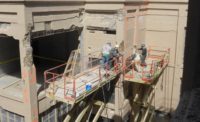As we head into the summer of 2016, it appears that construction is back and in some areas even booming. During the leaner times of the past 10 years, the contractors that made it through learned how to survive by taking efficiency to a whole new level. However, most of that efficiency has come as a result of improvements of transferring information through software and electronics.
In 2006, building information modeling (aka BIM) was rarely used by contractors but in 2016 it is almost a requirement for most large projects. In 2006, cell phones were primarily used to make phone calls, yet today they can be used as personal computers and can hold all the documents, photos and correspondence for your entire project. While management tools are great for a foreman or project manager, what innovations or improvements to efficiency have been developed for the benefit of the mechanic that labors in the field?
Reduce the Amount of “Steps” and “Touches”
Steps are counted as each individual part of the installation—or physical steps—taken to complete a task. Touches are counted every time the worker needs to touch a product or tool in order to complete a task. The less touches or steps, the more efficient the production.
Take something as simple as framing a metal stud wall and count the steps or touches. Steps are enumerated and touches are tallied in parenthesis below:
Step 1: Using a powder actuated nail gun to fasten the top track to the overhead structure (1); likewise fasten bottom track to the floor (2).
Step 2: Pull out a tape measure (3); Pull out a marker to transfer the stud layout and mark the bottom track leg (4); Use a laser or plumb bob to transfer the stud layout from the bottom track to the top track (5); Use a tape measure and maker to mark the stud layout on the track leg on the top track (6).
Step 3: Measure the studs to fit into the wall with the proper deflection (7); Cut studs (8); Install studs into the track (9).
Step 4: Clamp studs to the track (10) install framing screws (4 screws per stud) (11-14);
Total touches required for this application equals (14).
That’s basic metal stud framing 101. But if you are looking to reduce touches, how can you do it? If you are going to seriously look for ways to reduce touches, you need to get out of the mind set of that’s how it’s always been done. Contractors that stay in that mind set are typically still using plumb bobs and non-collated screw/nail guns and being out bid by contractors that stay current with technology and that are searching out products that provide efficiency and limit liability.
One such product that will help productivity in metal stud framing is CEMCO’s TAB Track. This offering is a screw-less metal stud framing system that does not require the use of a screw gun, does not require any framing screws, and does not require the use of clamps or a tape measure for layout. It locks the studs into layout, provides vertical deflection and prohibits lateral movement. This simple framing system reduces over half of the traditional touches and steps required to frame a wall.
Do Your Research
Understand the function and required performance of what you are building and then research products that will get you there in the most efficient manner.
Contractors that stay “old school” or narrow minded in their thinking will try to force old building methods into projects that have higher performance requirements. This will obviously lead to inefficiency, frustration, and a loss of profit.
One example where product innovation can improve performance centers on the pursuit of ever increasing STC ratings. Due to the trend toward urbanization and concentrated residential development, STC ratings on sound rated partitions continue to push higher and higher. Using standard drywall may not provide the designated STC rating for the project.
To meet this new need for better sound performance, several drywall manufacturers now offer sound dampening drywall. One layer of a sound dampening sheet of drywall will often provide a higher STC rating than two layers of a tradition sheet of drywall.
Greater performance requirements have also been placed upon fire and acoustic sealants. It should be noted that the STC and smoke ratings can be compromised by subpar sealant performance at the perimeter joint. Now, consider that most interior sealant manufacturers only provide between a one to three year performance warranty. This limited warranty could be disastrous for the contractor who is typically required to provide a much longer warranty as part of their contract.
When installing perimeter sealant for fire or sound protection, the following steps are required: First, clean out the joint removing all dirt and drywall dust to ensure proper adhesion to the edge of the drywall. Next, install backer rod or bond breaker tape to the back of the joint as required to prevent three-sided adhesion. Finally, tool in the sealant flush with the drywall.
This “old school” installation has not changed in more than 30 years. However, in 2016 contractors now have several alternate options for building joints. Several manufacturers now offer various solutions that reduce steps and touches with intumescent firestopping products. Interior building joints that do not require sealant are not subject to remedial or maintenance work caused by shrinking or separating sealant. Maybe more importantly, they are not limited by short-term warranties.
Avoid Budget Increase with Proper Designs
Architectural features are often detailed into the project drawings by the architect, yet constructing the architectural feature while remaining within compliance with the IBC and or fire ratings, is left up to the contractor.
Many times the fire rating requirement will greatly increase the cost of construction if not properly designed. Contractors that strive to work smarter and not harder will take the time in pre-construction to search out product options that will comply with building codes and provide the architectural feature desired by the owner. It’s not uncommon for an architect to note a product or a feature in a building and as a result, design that same feature in their building. They may not know the name of the product, but will likely assume it’s readily available because they saw it in another building. Thus the contractor that stays current with the latest innovations will have an advantage when new products and systems show up in plans.
Use your local manufacturer sales rep to fill you in on the latest product offerings. Oftentimes, manufacturers have already developed products that the architect has called out and a little research by the builder can go
a long way.







Report Abusive Comment